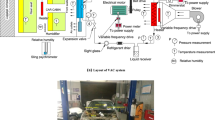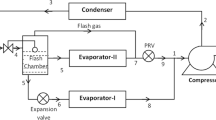Abstract
The refrigerant R134a is to be phasing out soon in automobile air conditioning applications due to its high global warming potential of 1430. Hence, it is essential to identify a sustainable alternative refrigerant to phase out R134a in automobile air conditioners. This paper presents the experimental thermodynamic performance of R430A (composed of R152a and R600a, in the ratio of 76:24, by mass) as a drop-in substitute to replace R134a in automobile air conditioners. The experiments were carried out in an automobile air conditioner test setup equipped with a variable frequency drive electrical motor. During experimentation, the ambient temperature and ambient relative humidity were maintained at 35 ± 1 °C and 65 ± 5%, respectively. The compressor speed was varied in the range between 1000 and 3000 rpm. The results showed that the coefficient of performance of an automobile air conditioner working with R430A was found to be 12–20% higher with 6–11% reduced compressor power consumption when compared to R134a. The R430A has 2–6 °C higher compressor discharge temperature when compared to R134a. The physical stability of the lubricant used in the compressor was retained while operating with R430A. The maximum exergy destruction occurs in the compressor (0.28 kW for R134a and 0.24 kW for R430A) followed by evaporator (0.16 kW for R134a and 0.14 kW for R430A), condenser (0.14 for R134a and 0.12 kW for R430A) and expansion valve (0.043 kW for R134a and 0.039 kW for R430A) at a compressor speed of 1000 ± 10 rpm. The exergy destruction of the system operating with R430A was found to be 12–28% lower when compared to R134a systems due to its favorable thermo-physical properties. The total equivalent warming impact of R430A was found to be lower when compared to R134a by about 47.3%, 35% and 32.4% for LPG, petrol and diesel vehicles, respectively. The results confirmed that R430A is a good drop-in substitute to replace R134a in existing automobile air conditioning systems.




















Similar content being viewed by others
Abbreviations
- COP:
-
Coefficient of performance
- GWP:
-
Global warming potential
- HC:
-
Hydrocarbon
- HFC:
-
Hydrofluorocarbon
- LPG:
-
Liquefied petroleum gas
- VFD:
-
Variable frequency drive
- A :
-
Area (m2)
- ex:
-
Specific exergy (kJ kg−1 K−1)
- \( \mathop {\text{Ex}}\limits^{ \bullet } \) :
-
Exergy rate (kJ K−1)
- E :
-
Energy consumption per day (in kW h year−1)
- h :
-
Specific enthalpy (kJ kg−1)
- L :
-
Leakage rate in the system (kg year−1)
- \( \mathop m\limits^{ \bullet } \) :
-
Mass flow rate (kg s−1)
- m :
-
Mass of refrigerant (kg)
- N :
-
Life of the system (years)
- n :
-
Operating time per day
- q :
-
Quantity
- R :
-
Given function
- s :
-
Specific entropy (kJ kg−1K−1)
- T :
-
Temperature (oC)
- w r :
-
Total uncertainty
- W :
-
Work (W)
- w 1, w 2, …, w n :
-
Uncertainty in the independent variables
- \( x_{1} \), \( x_{2} \),…, x n :
-
Independent variables
- α :
-
Refrigerant recycling factor
- β :
-
Carbon-dioxide emission factor (assumed as 0.9)
- ρ :
-
Density (kg m−3)
- η :
-
Efficiency (%)
- 0:
-
Dead state
- 1:
-
Compressor suction
- 2:
-
Compressor discharge
- 3:
-
Condenser outlet
- 4:
-
Expansion valve outlet
- cond:
-
Condenser
- comp:
-
Compressor
- dest,comp:
-
Destruction in compressor
- dest,cond:
-
Destruction in condenser
- dest,exp.val:
-
Destruction in expansion valve
- dest, evap:
-
Destruction in evaporator
- ele:
-
Electrical
- evap:
-
Evaporator
- ex:
-
Exergetic
- f:
-
Fuel
- gen:
-
Generation
- r:
-
Refrigerant
- vol:
-
Volumetric
References
Mohanraj M, Jayaraj S, Muraleedharan C. Environment friendly alternatives to halogenated refrigerants—a review. Int J Greenh Gas Control. 2009;3(1):108–19.
Mahmoud G. An investigation of R152a and hydrocarbon refrigerants in mobile air conditioning. In: SAE international paper no. 01-0874; 1999.
Cabello R, Sanchez D, Llopis R, Arauzo I, Torrella E. Experimental comparison between R152a and R134a working in a refrigeration facility equipped with a hermetic compressor. Int J Refrig. 2015;60:92–105.
Mohanraj M, Jayaraj S, Muraleedharan C. Comparative assessment of environment-friendly alternatives to R134a in domestic refrigerators. Energy Effic. 2008;1:189–98.
Maclaine-cross IL. Usage and risk of hydrocarbon refrigerants in motor cars for Australia and the United States. Int J Refrig. 2004;2004(27):339–45.
Wongwises S, Kamboon A, Orachon B. Experimental investigation of hydrocarbon mixtures to replace HFC134a in an automobile air conditioning system. Energy Convers Manag. 2006;47:1644–59.
Mohanraj M, Jayaraj S, Muraleedharan C. Experimental investigation of R290/R600a mixture as an alternative to R134a in a domestic refrigerator. Int J Therm Sci. 2009;48:1036–42.
Mohanraj M, Muraleedharan C, Jayaraj S. A review on recent developments in new refrigerant mixtures for vapour compression based refrigeration, air conditioning and heat pump units. Int J Energy Res. 2011;35(8):647–69.
Sánchez D, Cabello R, Llopis R, Arauzo I, Torrella E. Energy performance evaluation of R1234yf, R1234ze (E), R600a, R290 and R152a as low-GWP R134a alternatives. Int J Refrig. 2017;74:269–82.
Mota-Babiloni A, Navarro-Esbrí J, Barrag A, Moles F, Peris B. Drop-in energy performance evaluation of R1234yf and R1234ze(E) in a vapor compression system as R134a replacements. Appl Therm Eng. 2014;71:259–65.
Zilio C, Brown JS, Schiochet G, Cavallini A. The refrigerant R1234yf in air conditioning systems. Energy. 2011;36:6110–20.
Zhao Y, Qi Z, Chen J, Xu B, He B. Experimental analysis of the low-GWP refrigerant R1234yf as a drop-in replacement for R134a in a typical mobile air conditioning system. Proc Inst Mech Eng C J Mech Eng Sci. 2012;226(11):2713–25.
Lee Y, Jung D. A brief performance comparison of R1234yf and R134a in a bench tester for automobile air applications. Appl Therm Eng. 2012;35:240–2.
Qi Z. Experimental study on evaporator performance in automobile air conditioning system using HFO1234yf as working fluid. Appl Therm Eng. 2013;53:124–30.
Cho H, Lee H, Park C. Performance characteristics of an automobile air conditioning system with internal heat exchanger using refrigerant R1234yf. Appl Therm Eng. 2013;61:563–9.
Meng Z, Zhang H, Mingjing L, Qin Y, Jinyou Q. Performance of low GWP R1234yf/R134a mixture as a replacement for R134a in automotive air conditioning systems. Int J Heat Mass Transf. 2018;116:362–70.
Zhai Z, Wu J, Hu X, Li L, Guo J, Zhang B, Hu J, Zhang J. A 17-fold increase of trifluoroacetic acid in landscape waters of Beijing, China during the last decade. Chemosphere. 2015;129:110–7.
Park K-J, Jung DS. Performance of alternative refrigerant R430A on domestic water purifiers. Energy Convers Manag. 2009;50:3045–50.
Mohanraj M. Energy performance assessment of R430A as a possible alternative refrigerant to R134a in domestic refrigerators. Energy Sustain Dev. 2013;17:471–6.
Mohanraj M. Experimental investigations of R430A as drop—in substitute to R134a in domestic refrigerators. Proc Mech Eng E J Process Mech Eng (Article in Press).
Golzari S, Kasaeian A, Daviran S, Mahian O, Wongwises S, Sahin AZ. Second law analysis of an automotive air conditioning system using HFO-1234yf, an environmentally friendly refrigerant. Int J Refrig. 2017;73:134–43.
Cho H, Park C. Experimental investigation of performance and exergy analysis of automotive air conditioning systems using refrigerant R1234yf at various compressor speeds. Appl Therm Eng. 2016;101:30–7.
Li G, Eisele M, Lee H, Hwang Y, Radermacher R. Experimental investigation of energy and exergy performance of secondary loop automotive air-conditioning systems using low-GWP (global warming potential) refrigerants. Energy. 2014;68:819–31.
Prabakaran R, Mohan Lal D. A novel exergy optimization for a mobile air conditioning system. J Therm Anal Calorim. 2018;132:1241–52.
Prabakaran R, Lal DM, Prabhakaran A, Kumar JK. Experimental investigations on the performance enhancement using microchannel evaporator with integrated receiver-dryer condenser in an automotive air conditioning system. Heat Transfer Eng 2018; (Article in Press).
Holman JP. Experimental methods for engineers. New Delhi: Tata Mc Graw Hill Publishers; 2007.
Paradeshi L, Mohanraj M, Srinivas M, Jayaraj S. Exergy analysis of direct-expansion solar-assisted heat pumps working with R22 and R433A. J Therm Anal Calorim. 2018 (in press).
Daviran S, Kasaeian A, Golzari S, Mahian O, Nasirivatan S, Wongwises S. A comparative study on the performance of HFO-1234yf and HFC-134a as an alternative in automotive air conditioning systems. Appl Therm Eng. 2017;110:1091–100.
Raveendran PS, Sekhar SJ. Exergy analysis of a domestic refrigerator with brazed heat exchanger as condenser. J Therm Anal Calorim. 2017;127:2439–46.
Fischer SK. Total equivalent warming impact: a measure of the global warming impact of CFC alternatives in refrigerating equipment. Int J Refrig. 1993;16:423–8.
Maclaine-cross IL, Leonardi E. Why hydrocarbons save energy. AIRAH J. 1997;51:33–7.
Acknowledgements
The R430A sample provided by Hans Industrial Corporation is highly acknowledged.
Author information
Authors and Affiliations
Corresponding author
Annexure
Annexure
The uncertainty of calculated performance parameters are given by:
Mass flow rate
Refrigeration effect
Compressor power consumption
Coefficient of performance
Exergy destruction in compressor
Exergy destruction in condenser
Exergy destruction in an expansion device
Exergy destruction in an evaporator
Exergy destruction in a system
Rights and permissions
About this article
Cite this article
Andrew Pon Abraham, J.D., Mohanraj, M. Thermodynamic performance of automobile air conditioners working with R430A as a drop-in substitute to R134a. J Therm Anal Calorim 136, 2071–2086 (2019). https://doi.org/10.1007/s10973-018-7843-1
Received:
Accepted:
Published:
Issue Date:
DOI: https://doi.org/10.1007/s10973-018-7843-1




